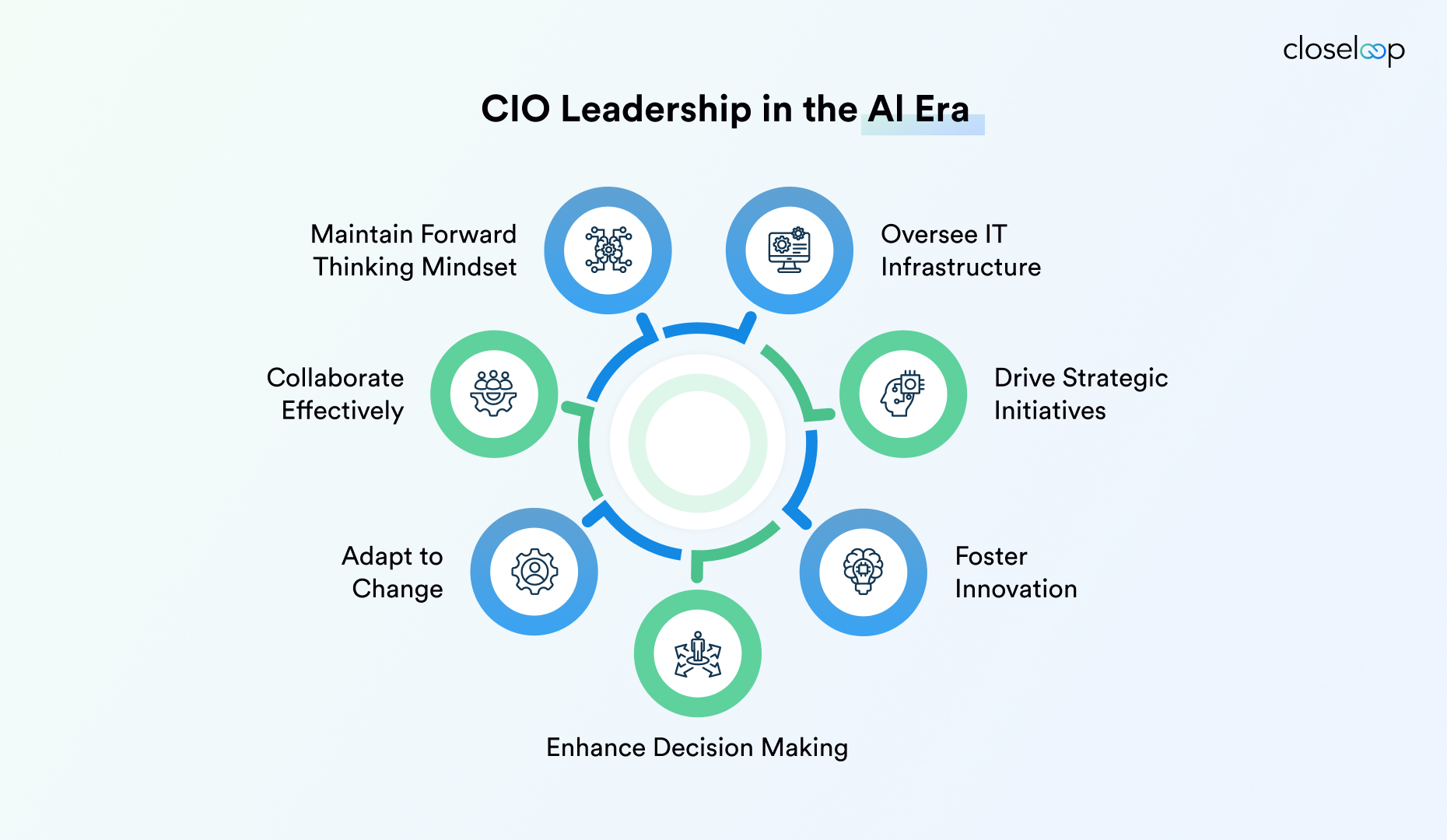The Chief Information Officer role has undergone a profound transformation in the age of artificial intelligence. It has shifted from traditional technology management to strategic business leadership and CIO and AI strategy focused on value creation and organizational transformation. As AI technologies mature and business expectations intensify, CIOs find themselves at the epicenter of one of the most significant technological shifts in modern business history. This shift presents unprecedented opportunities to drive competitive advantage and operational excellence.
By leading the charge on GenAI, they can boost productivity within the tech function while demonstrating how CIOs drive AI adoption. They can also help spark a true AI transformation across the larger organization, positioning themselves as catalysts for enterprise-wide innovation and efficiency gains through CIO leadership in AI.
However, this opportunity comes with substantial challenges: Nearly half of all AI leaders question how to estimate or demonstrate the value of AI-related technologies, creating pressure to develop sophisticated value measurement and delivery frameworks as part of CIO responsibilities in AI initiatives.
The stakes for CIOs have never been higher! Experienced CIOs know there is never a blank check for transformation and innovation investments, and they expect more pressure in 2025 to deliver business value from gen AI investments, while simultaneously managing the complexities of emerging technologies, evolving regulatory landscapes, and organizational change management requirements, a core AI implementation leadership challenge.

This comprehensive analysis by Closeloop examines the critical dimensions of the modern CIO's role in AI value creation. It provides strategic frameworks, practical methodologies, and actionable insights including best practices for CIOs in AI strategy and an enterprise AI roadmap for CIOs. These are designed for technology leaders aiming to maximize their AI investments and demonstrate measurable business impact in an increasingly competitive and complex environment.
Key Takeaways
-
CIOs evolve as strategic leaders in AI transformation, blending vision, collaboration, and change management (the strategic role of CIO in AI)
-
92% expect AI integration by 2025, but 49% struggle to prove AI's ROI, making value demonstration crucial (AI implementation leadership and value proof)
-
AI project abandonment rose to 42% in 2025, underscoring the need for strong value measurement under CIO responsibilities in AI initiatives
-
CIOs must implement AI governance, balancing innovation, compliance, ethics, and risk (AI governance and CIO responsibilities)
-
They drive cultural change for AI-driven decisions, collaboration, and continuous learning (showing how CIOs drive AI adoption)
-
Building partnerships with business units and vendors is key to successful AI adoption (enabling CIOs driving business value with AI)
The Evolution of CIO Leadership in the AI Era
The traditional boundaries of IT leadership have fundamentally shifted as artificial intelligence transforms from experimental technology to business-critical infrastructure. Modern CIOs must navigate this transformation while balancing innovation imperatives with operational excellence, risk management, and stakeholder expectations through cohesive CIO and AI strategy. Understanding this evolving landscape is essential for CIOs seeking to establish themselves as strategic business leaders capable of driving a sustained future of AI value creation in close CIO collaboration with data and AI teams.

From Technology Manager to Strategic Business Leader
The modern CIO has evolved from managing technology infrastructure to becoming a strategic business leader driving innovation and organizational transformation (the CIO role in AI now tied to outcomes). In 2025, CIOs must pinpoint AI use cases that deliver clear business value, combining deep technical expertise with strong business acumen and aligning with an enterprise AI roadmap for CIOs.
They need to understand market dynamics, competitive landscapes, and customer needs as well as technology, translating AI capabilities into tangible value for executives and stakeholders so that CIOs drive business value with AI. Acting as a bridge between technology and business, CIOs continuously engage with business units, customers, and partners to identify AI-driven opportunities that enhance efficiency, solve real problems, and generate new revenue streams while upholding AI governance and CIO responsibilities.
ALSO READ: Do you need a Chief AI Officer?
Building Cross-Functional AI Leadership Capabilities
Successful AI value creation demands that CIOs build cross-functional leadership capabilities by coordinating data science, engineering, legal, compliance, and business teams with varying priorities, practical CIO leadership in AI. They must establish governance structures for clear decision-making and accountability reflecting CIO responsibilities in AI initiatives. In addition, they should develop communication frameworks to translate technical concepts for business stakeholders and implement project management methods tailored to AI’s iterative nature (a hallmark of AI implementation leadership).
Additionally, CIOs should foster partnerships with external vendors, consultants, academia, and industry networks to access specialized expertise, speed development, and share best practices, ensuring effective AI adoption and value delivery as CIOs driving business value with AI.
Strategic Framework for AI Value Creation
Developing a comprehensive strategy for AI value creation requires CIOs to establish clear frameworks that guide investment decisions as part of a unified CIO and AI strategy. These frameworks should also help prioritize initiatives and measure success across diverse business functions and use cases. These frameworks must balance short-term efficiency gains with long-term transformation objectives while maintaining alignment with organizational strategy and stakeholder expectations (a pragmatic enterprise AI roadmap for CIOs).
Value Identification and Prioritization Methodologies
Successfully navigating this landscape requires a strategic approach. Organizations must identify and capitalize on AI initiatives that demonstrably improve the bottom line (a core part of CIO and AI strategy). This calls for systematic methodologies to evaluate potential AI applications and prioritize investments based on value potential and implementation feasibility, reflecting best practices for CIOs in AI strategy.
|
Value Assessment Criteria |
Weight |
High Value Indicators |
Medium Value Indicators |
Low Value Indicators |
|
Business Impact Potential |
30% |
Revenue increase >15%, Cost reduction >25% |
Revenue increases 5-15%, Cost reduction 10-25% |
Revenue increase <5%, Cost reduction <10% |
|
Implementation Feasibility |
25% |
Existing data/systems, Clear process |
Some integration needed, Defined requirements |
Major infrastructure changes required |
|
Strategic Alignment |
20% |
Core business objective, Executive priority |
Supporting business goal, Department priority |
Nice-to-have capability, Individual request |
|
ROI Timeline |
15% |
Value realization <12 months |
Value realization 12-24 months |
Value realization >24 months |
|
Risk Level |
10% |
Low regulatory/operational risk |
Moderate risk with mitigation |
High risk, significant uncertainty |
The prioritization process should incorporate quantitative analysis of potential returns alongside qualitative assessment of strategic fit and organizational readiness. CIOs must develop business cases that clearly articulate value propositions, implementation requirements, success metrics, and risk mitigation strategies for each potential AI initiative, central to CIO responsibilities in AI initiatives and CIOs driving business value with AI.
ALSO READ: AI in Travel Industry
Portfolio Management and Resource Allocation
Effective AI value creation requires portfolio management approaches that balance high-certainty, incremental improvements with higher-risk, transformational initiatives. CIOs should allocate resources across a diversified portfolio that includes quick wins, strategic bets, and experimental projects that explore emerging capabilities and market opportunities (codifying how CIOs drive AI adoption).
The portfolio management framework should establish clear governance processes for project approval, resource allocation, performance monitoring, and strategic pivoting based on changing business conditions or technology developments, an example of AI implementation leadership. This includes establishing stage-gate processes that enable evidence-based decision-making about continuing, modifying, or terminating AI initiatives within an enterprise AI roadmap for CIOs.
Closeloop Tip: Implement a three-horizon portfolio approach: 70% for proven AI applications with clear ROI, 20% for emerging opportunities with strategic potential, and 10% for experimental projects that explore cutting-edge capabilities and future possibilities, a pragmatic guide for the strategic role of CIO in AI.
Measuring and Demonstrating AI ROI
The challenge of measuring and demonstrating AI return on investment has emerged as one of the most critical obstacles facing CIOs in their value creation efforts (one of the key challenges CIOs face in AI adoption). Traditional ROI measurement approaches often prove inadequate for AI initiatives that deliver diverse benefits across multiple organizational functions and timeframes. Developing sophisticated measurement frameworks is essential for maintaining stakeholder support and securing continued investment in AI capabilities, a priority for CIO leadership in AI.
Understanding the AI ROI Challenge
A report by the IBM Institute for Business Value found that enterprise-wide AI initiatives achieved an ROI of just 5.9%. Meanwhile, those same AI projects incurred a 10% capital investment, highlighting the significant gap between AI investment levels and realized returns that many organizations experience.
Most businesses estimated returns of 50% or less on their AI projects, according to a CDW report. In contrast, Deloitte found that nearly all organizations saw measurable ROI from their generative AI efforts over the year. About 20% of respondents reported an ROI of 30% or more, highlighting the wide variation in AI value realization across organizations and implementation strategies, underscoring why CIOs driving business value with AI need consistent metrics.
|
ROI Measurement Challenge |
Traditional IT Projects |
AI Projects |
CIO Response Strategy |
|
Value Attribution |
Direct cost-benefit mapping |
Multi-faceted, indirect benefits |
Develop comprehensive value frameworks |
|
Measurement Timeline |
Fixed implementation cycles |
Continuous learning and improvement |
Establish ongoing measurement processes |
|
Success Metrics |
Technical performance KPIs |
Business outcome indicators |
Define hybrid measurement approaches |
|
Stakeholder Alignment |
IT-focused metrics |
Cross-functional value creation |
Create business-relevant dashboards |
|
Investment Justification |
Upfront business case |
Evolving value realization |
Implement dynamic ROI tracking |
The complexity of AI ROI measurement stems from the technology's ability to deliver value across multiple dimensions simultaneously, including operational efficiency, decision-making quality, customer experience, and strategic capability development. CIOs must develop measurement frameworks that capture these diverse value streams while providing clear, actionable insights for stakeholders (integral to CIO responsibilities in AI initiatives).
Comprehensive ROI Measurement Frameworks
At its core, ROI measures the profitability of an investment. For AI projects, this involves comparing the financial gains obtained from the AI implementation against the total costs invested. Effective measurement, however, requires sophisticated approaches that account for both quantitative and qualitative benefits, a hallmark of AI implementation leadership.
Successful CIOs implement multi-dimensional measurement frameworks that track financial returns, operational improvements, strategic capability development, and organizational learning outcomes within an enterprise AI roadmap for CIOs. These frameworks should establish baseline measurements before AI implementation, define success metrics aligned with business objectives, and create reporting mechanisms that communicate value to diverse stakeholder audiences (enabling CIO collaboration with data and AI teams).
Closeloop Tip: Establish leading indicators (process improvements, user adoption rates, data quality metrics) alongside lagging indicators (revenue impact, cost savings, customer satisfaction) to provide early signals of AI value creation and enable proactive optimization, a practical best practice for CIOs in AI strategy.
ALSO READ: AI in Data Analytics: Applications and Challenges
Value Communication and Stakeholder Management
Unlike traditional IT initiatives, AI projects often deliver multifaceted benefits that are harder to quantify. This requires CIOs to develop sophisticated communication strategies as part of CIO leadership in AI. They must translate complex technical achievements into business value narratives that resonate with different stakeholder groups and reinforce CIOs driving business value with AI.
Effective value communication involves creating tailored reporting frameworks for different audiences, from technical metrics for engineering teams to strategic outcomes for executive leadership and board members (showcasing CIO and AI strategy in action). CIOs must also establish regular communication cadences that keep stakeholders informed about progress, challenges, and emerging opportunities, which are core CIO responsibilities in AI initiatives.
Governance and Risk Management in AI Implementation
As AI systems become more sophisticated and autonomous, CIOs must establish comprehensive governance frameworks. These frameworks should balance innovation velocity with appropriate risk management, regulatory compliance, and ethical considerations (core to AI governance and CIO responsibilities and CIO responsibilities in AI initiatives). These frameworks must address the unique challenges posed by AI technologies while enabling organizational agility and competitive advantage through intelligent automation and decision support capabilities, evidence of CIO leadership in AI.
Establishing AI Governance Frameworks
In the upcoming years, CIOs should integrate their data and AI governance efforts while focusing on data security to reduce risks as part of a unified CIO and AI strategy. Driving business benefits will also require a strong emphasis on improving data quality. Achieving this demands comprehensive approaches that simultaneously address technology, processes, and organizational structures, practical best practices for CIOs in AI strategy.
Effective AI governance frameworks establish clear roles and responsibilities for AI development, deployment, and monitoring across organizational levels (codifying CIO responsibilities in AI initiatives). This includes defining decision-making authorities for different types of AI initiatives, establishing approval processes for high-risk applications, and creating accountability mechanisms that ensure appropriate oversight of autonomous systems.
|
Governance Component |
Scope |
Key Considerations |
Implementation Approach |
|
AI Ethics Committee |
Organization-wide |
Bias prevention, Fairness, Transparency |
Cross-functional team with external advisors |
|
Technical Standards |
Development teams |
Model validation, Performance monitoring, Security |
Automated testing and continuous monitoring |
|
Data Governance |
Data and analytics teams |
Quality, Privacy, Compliance |
Integrated data management platforms |
|
Risk Assessment |
Business units |
Operational, Regulatory, Reputational risks |
Regular risk reviews and mitigation planning |
|
Compliance Monitoring |
Legal and compliance teams |
Regulatory requirements, Audit trails |
Automated compliance checking and reporting |
The governance framework should also address intellectual property considerations, vendor management requirements, and partnership agreements within an enterprise AI roadmap for CIOs. These agreements govern access to AI capabilities, data sharing, and collaborative development efforts with external organizations and require CIO collaboration with data and AI teams.
Risk Assessment and Mitigation Strategies
AI implementations introduce unique risk categories that traditional IT risk management approaches may not adequately address. CIOs must develop specialized risk assessment methodologies that evaluate AI-specific threats, including algorithmic bias, model degradation, adversarial attacks, and unintended autonomous behaviors (a key challenge CIOs face in AI adoption).
Processing AI within the same managed environment as workflows and applications keeps it local, safe, and secure, highlighting the importance of architectural decisions in risk mitigation strategies. CIOs should implement defense-in-depth approaches that combine technical controls, process safeguards, and human oversight mechanisms, hallmarks of AI implementation leadership.
Closeloop Tip: Develop AI-specific incident response procedures that address model failures, bias detection, and performance degradation scenarios with clear escalation paths and recovery mechanisms to minimize business disruption (reinforcing CIO leadership in AI).
Organizational Change and Culture Development
Successful AI value creation requires more than technology implementation—it demands fundamental organizational transformation that enables AI-driven decision making, cross-functional collaboration, and continuous learning capabilities (the strategic role of CIO in AI). CIOs must lead cultural change initiatives that prepare their organizations for the human-AI collaboration models that define competitive advantage in the AI era, showcasing how CIOs drive AI adoption.
Building AI-Ready Organizational Capabilities
The transformation to an AI-enabled organization requires developing new competencies across multiple organizational levels, from individual skill development to enterprise-wide process redesign. CIOs must assess current organizational capabilities, identify capability gaps, and develop comprehensive development programs that prepare teams for AI collaboration.
This capability development includes technical skills like data literacy and AI tool proficiency alongside soft skills like critical thinking, creative problem-solving, and adaptability that enable effective human-AI collaboration. Organizations must also develop new roles and career paths that reflect the evolving nature of work in AI-augmented environments (a priority in an enterprise AI roadmap for CIOs).
|
Organizational Level |
Required Capabilities |
Development Approach |
Success Metrics |
|
Executive Leadership |
AI strategy, Value assessment, Risk oversight |
Executive education, Strategic planning workshops |
AI investment decisions, Strategic alignment |
|
Middle Management |
AI project management, Change leadership, Performance measurement |
Management training, Cross-functional collaboration |
Project success rates, Team adoption metrics |
|
Technical Teams |
AI development, Integration, Monitoring |
Technical certification, Hands-on projects |
Model performance, Implementation velocity |
|
Business Users |
AI tool proficiency, Data interpretation, Process optimization |
User training, Continuous support |
User adoption rates, Productivity improvements |
|
Support Functions |
AI governance, Compliance monitoring, Risk assessment |
Specialized training, Policy development |
Governance effectiveness, Risk mitigation |
Change Management for AI Adoption
Implementing AI technologies often requires significant changes to established workflows, decision-making processes, and organizational structures. CIOs must develop change management strategies that address resistance, build confidence, and create momentum for AI adoption across diverse stakeholder groups (demonstrating CIO leadership in AI).
Effective change management for AI adoption involves creating compelling visions for the AI-enabled future, demonstrating quick wins that build credibility, and providing comprehensive support systems that help individuals and teams navigate the transition successfully, practical best practices for CIOs in AI strategy. This includes addressing concerns about job displacement, skill obsolescence, and loss of autonomy that often accompany AI implementations, one of the challenges CIOs face in AI adoption.
ALSO READ: A guide to safe and compliant AI adoption
Closeloop Tip: Implement pilot programs that showcase AI value in low-risk, high-visibility scenarios to build organizational confidence and create AI advocates who can drive broader adoption across business units.
Technology Architecture and Infrastructure Strategy
The success of AI value creation initiatives depends heavily on underlying technology architecture and infrastructure capabilities that enable efficient data processing, model deployment, and system integration. CIOs must develop comprehensive technology strategies as part of a CIO and AI strategy and an enterprise AI roadmap for CIOs that support current AI applications while providing flexibility for future innovation and scaling requirements, demonstrating CIO leadership in AI.
AI-Optimized Infrastructure Design
CIOs can also prioritize platforms that unify data, applications and infrastructure while enabling AI-powered architectures - particularly AI - as a driver of operational efficiency, requiring infrastructure strategies that balance performance, cost, and scalability considerations for diverse AI workloads (a hallmark of AI implementation leadership).
Modern AI infrastructure must support multiple deployment models, from cloud-native solutions that provide unlimited scaling capabilities to edge computing implementations that enable real-time decision making in distributed environments and require tight CIO collaboration with data and AI teams. The architecture should also accommodate hybrid approaches that combine on-premises and cloud resources based on security, compliance, and performance requirements, aligning with CIO responsibilities in AI initiatives.
|
Infrastructure Component |
Traditional IT Requirements |
AI-Specific Considerations |
Strategic Implications |
|
Compute Resources |
Predictable workload patterns |
Variable, intensive processing bursts |
Dynamic scaling, Cost optimization |
|
Storage Systems |
Structured data management |
Unstructured data, Large datasets |
Data lake architectures, Tiered storage |
|
Network Infrastructure |
Standard bandwidth requirements |
High-throughput data transfer |
Low-latency connectivity, Edge deployment |
|
Security Architecture |
Perimeter-based protection |
AI-specific threat vectors |
Zero-trust models, Continuous monitoring |
|
Integration Platforms |
Point-to-point connections |
Real-time data streaming |
Event-driven architectures, API management |
The infrastructure strategy should also address model lifecycle management requirements, including development environments, testing frameworks, deployment pipelines, and monitoring systems that ensure consistent performance and reliability across production environments (reflecting the strategic role of CIO in AI).
ALSO READ: Use Case of AI in Retail
Data Architecture and Management Strategy
Leveraging technologies, such as analytics and generative AI services, promises to make data both more meaningful and more rapidly available in the right context. Doing so requires a robust data management strategy, underscoring AI governance and CIO responsibilities and highlighting the critical importance of comprehensive data strategies for AI success.
Effective data architecture for AI value creation must address data quality, accessibility, governance, and security requirements while enabling real-time analytics and model training capabilities within an enterprise AI roadmap for CIOs. This includes implementing data fabric or data mesh architectures that provide unified access to distributed data sources while maintaining appropriate security and compliance controls through CIO collaboration with data and AI teams.
Closeloop Tip: Implement comprehensive data cataloging and lineage tracking systems that provide visibility into data sources, transformations, and usage patterns to support model validation, compliance reporting, and optimization efforts, a practical best practice for CIOs in AI strategy.
Future-Proofing AI Investments and Capabilities
The rapid pace of AI technology evolution requires CIOs to develop strategies that protect current investments while positioning organizations to capitalize on emerging capabilities and market opportunities (the future of CIO role in AI transformation). Future-proofing approaches must balance the need for standardization and stability with the flexibility to adapt to technological advances and changing business requirements, evidence of CIO leadership in AI.
Emerging Technology Integration Planning
CIOs must monitor emerging AI technologies and assess their potential impact on existing systems, processes, and competitive positioning as part of CIO responsibilities in AI initiatives. This includes evaluating capabilities like agentic AI, multimodal AI, quantum-enhanced machine learning, and neuromorphic computing that may transform current AI applications and create new value creation opportunities.
The AI integration planning process should establish criteria for evaluating new technologies, develop pilot programs for testing emerging capabilities, and create migration strategies that minimize disruption while maximizing value from technology transitions (addressing challenges CIOs face in AI adoption). This requires balancing innovation exploration with operational stability and risk management considerations.
|
Emerging Technology |
Maturity Timeline |
Value Creation Potential |
Integration Complexity |
Strategic Priority |
|
Agentic AI |
2025-2027 |
High - Autonomous task completion |
Medium - API integration |
High |
|
Multimodal AI |
2025-2026 |
Medium - Enhanced user experiences |
Medium - Data pipeline changes |
Medium |
|
Quantum ML |
2027-2030 |
High - Complex optimization problems |
High - Infrastructure requirements |
Low |
|
Neuromorphic Computing |
2028-2032 |
Medium - Edge AI applications |
High - Hardware/software changes |
Low |
|
Federated Learning |
2025-2027 |
Medium - Privacy-preserving ML |
Medium - Network architecture |
Medium |
Strategic Partnership and Ecosystem Development
AI value creation increasingly depends on strategic partnerships with technology vendors, research institutions, and industry collaborators that provide access to specialized capabilities, accelerate development timelines, and share implementation risks, a lever for CIOs driving business value with AI. CIOs must develop partnership strategies that align with organizational objectives while maintaining strategic flexibility and model AI implementation leadership.
Effective partnership approaches involve establishing clear criteria for partner selection, developing governance frameworks for collaborative development, and creating performance measurement systems that ensure mutual value creation (demonstrating CIO leadership in AI). This includes managing intellectual property considerations, data sharing agreements, and competitive dynamics that may influence partnership effectiveness.
Closeloop Tip: Build diverse partnership portfolios that include established technology vendors for stable capabilities, innovative startups for cutting-edge solutions, and academic institutions for research and talent development to create comprehensive AI ecosystems within an enterprise AI roadmap for CIOs.
How Closeloop Can Accelerate Your AI Value Creation Journey
Navigating AI value creation is a complex task for CIOs, involving not just technology implementation but also business strategy, change management, and compliance with evolving regulations (a reality of the CIO role in AI and the challenges CIOs face in AI adoption). Many leaders face challenges such as identifying impactful use cases, measuring ROI, and driving organizational change. With experience across multiple industries, Closeloop offers guidance and support to help organizations accelerate AI initiatives, manage risks, and achieve stronger returns on investment, partnering closely on CIO leadership in AI.
As one of the leading artificial intelligence development companies in California, our approach combines technical expertise with strategic insight, helping CIOs build and execute AI strategies (a pragmatic CIO and AI strategy) that produce tangible business outcomes while maintaining operational integrity. Recognizing that successful AI transformation goes beyond technology, our AI integration services cover every stage, from strategy and implementation to culture building and ongoing optimization, ensuring organizations realize sustained value from their AI investments and enabling CIOs to drive business value with AI.
We provide:
-
AI Strategy and Value Assessment: Comprehensive evaluation of your AI readiness, identification of high-value use cases, development of strategic roadmaps, and establishment of governance frameworks that align AI investments with business objectives and stakeholder expectations (groundwork for an enterprise AI roadmap for CIOs)
-
ROI Measurement and Value Tracking: Implementation of sophisticated measurement frameworks that capture multi-dimensional AI value creation, establish baseline metrics, track progress against objectives, and provide compelling value narratives for diverse stakeholder audiences (supporting AI implementation leadership)
-
Organizational Transformation Support: Change management programs that prepare your organization for AI adoption, capability development initiatives that build AI-ready teams, and cultural transformation strategies that enable effective human-AI collaboration across all organizational levels (driving how CIOs drive AI adoption)
-
Technology Architecture and Implementation: Design and deployment of AI-optimized infrastructure, integration with existing systems, implementation of governance and security frameworks, and establishment of monitoring and optimization processes that ensure sustained performance (aligned to AI governance and CIO responsibilities)
-
Risk Management and Compliance: Development of comprehensive risk assessment methodologies, implementation of AI-specific governance controls, establishment of compliance monitoring systems, and creation of incident response procedures that protect organizational assets and reputation (core CIO responsibilities in AI initiatives)
-
Continuous Optimization and Evolution: Ongoing performance monitoring, strategic plan refinement, emerging technology evaluation, and capability enhancement services that ensure your AI investments continue delivering value as technologies and business requirements evolve (anticipating the future of CIO role in AI transformation)
Conclusion
In the AI era, Chief Information Officers (CIOs) stand at the forefront of organizational transformation, facing both immense opportunities and substantial challenges. While a vast majority of CIOs plan for AI integration by 2025, the high rate of project abandonment due to cost and lack of clear value underscores the need for strategic planning, robust frameworks, and consistent leadership (the essence of CIO leadership in AI). Achieving success requires CIOs to balance rapid innovation with operational rigor, build strong governance and measurement systems, and guide their organizations through complex regulatory and stakeholder landscapes as part of a cohesive CIO and AI strategy.
Navigating these demands often benefits from the support of experienced partners such as Closeloop, who bring specialized expertise and proven methodologies. Ultimately, CIOs who lead with vision developing comprehensive strategies and fostering an AI-ready culture will be best positioned to realize tangible business value and secure lasting competitive advantage in an increasingly AI-driven marketplace, clear proof of CIOs driving business value with AI, enabled by CIO collaboration with data and AI teams and anchored in best practices for CIOs in AI strategy.
Let's discuss your next AI integration project with our expert AI consultants at Closeloop.
Start the Conversation
We collaborate with companies worldwide to design custom IT solutions, offer cutting-edge technical consultation, and seamlessly integrate business-changing systems.
Get in TouchUnlock the power of AI and Automation for your business with our no-cost workshop.
Join our team of experts to explore the transformative potential of intelligent automation. From understanding the latest trends to designing tailored solutions, our workshop provides personalized consultations, empowering you to drive growth and efficiency.
Go to Workshop DetailsExplore Our Latest Articles
Stay abreast of what’s trending in the world of technology with our well-researched and curated articles
View More InsightsCost Breakdown to Build a Custom Logistics Software: Complete Guide
Global logistics is transforming faster than ever. Real-time visibility, automation, and AI...
Logistics Software Development Guide: Types, Features, Industry Solutions & Benefits
The logistics and transportation industry is evolving faster than ever. It’s no longer...
From Hurdle to Success: Conquering the Top 5 Cloud Adoption Challenges
Cloud adoption continues to accelerate across enterprises, yet significant barriers persist....
Gen AI for HR: Scaling Impact and Redefining the Workplace
The human resources landscape stands at a critical inflection point. Generative AI in HR has...




